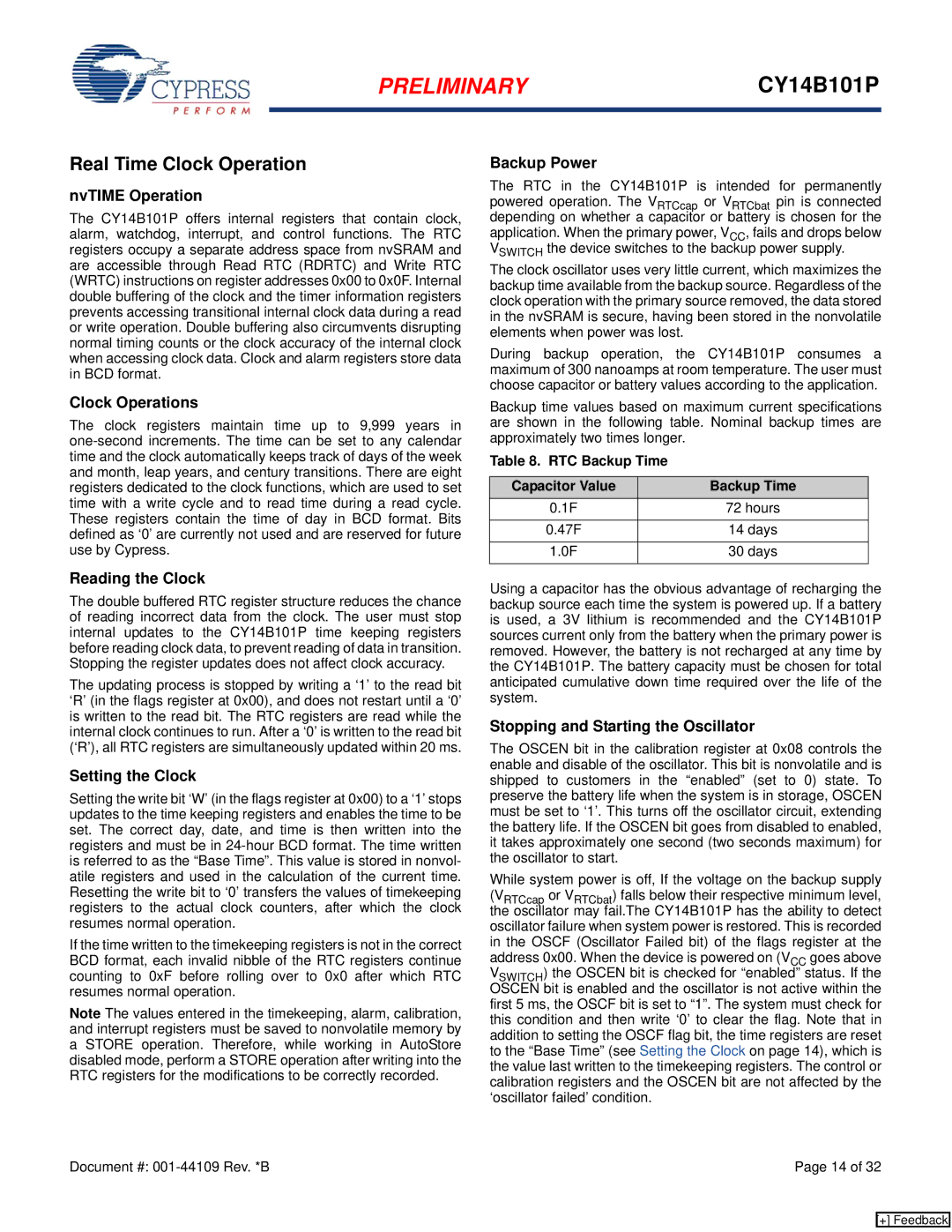
PRELIMINARYCY14B101P
Real Time Clock Operation
nvTIME Operation
The CY14B101P offers internal registers that contain clock, alarm, watchdog, interrupt, and control functions. The RTC registers occupy a separate address space from nvSRAM and are accessible through Read RTC (RDRTC) and Write RTC (WRTC) instructions on register addresses 0x00 to 0x0F. Internal double buffering of the clock and the timer information registers prevents accessing transitional internal clock data during a read or write operation. Double buffering also circumvents disrupting normal timing counts or the clock accuracy of the internal clock when accessing clock data. Clock and alarm registers store data in BCD format.
Backup Power
The RTC in the CY14B101P is intended for permanently powered operation. The VRTCcap or VRTCbat pin is connected depending on whether a capacitor or battery is chosen for the application. When the primary power, VCC, fails and drops below VSWITCH the device switches to the backup power supply.
The clock oscillator uses very little current, which maximizes the backup time available from the backup source. Regardless of the clock operation with the primary source removed, the data stored in the nvSRAM is secure, having been stored in the nonvolatile elements when power was lost.
During backup operation, the CY14B101P consumes a maximum of 300 nanoamps at room temperature. The user must choose capacitor or battery values according to the application.
Clock Operations
The clock registers maintain time up to 9,999 years in
Reading the Clock
The double buffered RTC register structure reduces the chance of reading incorrect data from the clock. The user must stop internal updates to the CY14B101P time keeping registers before reading clock data, to prevent reading of data in transition. Stopping the register updates does not affect clock accuracy.
The updating process is stopped by writing a ‘1’ to the read bit ‘R’ (in the flags register at 0x00), and does not restart until a ‘0’ is written to the read bit. The RTC registers are read while the internal clock continues to run. After a ‘0’ is written to the read bit (‘R’), all RTC registers are simultaneously updated within 20 ms.
Setting the Clock
Setting the write bit ‘W’ (in the flags register at 0x00) to a ‘1’ stops updates to the time keeping registers and enables the time to be set. The correct day, date, and time is then written into the registers and must be in
If the time written to the timekeeping registers is not in the correct BCD format, each invalid nibble of the RTC registers continue counting to 0xF before rolling over to 0x0 after which RTC resumes normal operation.
Note The values entered in the timekeeping, alarm, calibration, and interrupt registers must be saved to nonvolatile memory by a STORE operation. Therefore, while working in AutoStore disabled mode, perform a STORE operation after writing into the RTC registers for the modifications to be correctly recorded.
Backup time values based on maximum current specifications are shown in the following table. Nominal backup times are approximately two times longer.
Table 8. RTC Backup Time
Capacitor Value | Backup Time |
0.1F | 72 hours |
|
|
0.47F | 14 days |
|
|
1.0F | 30 days |
|
|
Using a capacitor has the obvious advantage of recharging the backup source each time the system is powered up. If a battery is used, a 3V lithium is recommended and the CY14B101P sources current only from the battery when the primary power is removed. However, the battery is not recharged at any time by the CY14B101P. The battery capacity must be chosen for total anticipated cumulative down time required over the life of the system.
Stopping and Starting the Oscillator
The OSCEN bit in the calibration register at 0x08 controls the enable and disable of the oscillator. This bit is nonvolatile and is shipped to customers in the “enabled” (set to 0) state. To preserve the battery life when the system is in storage, OSCEN must be set to ‘1’. This turns off the oscillator circuit, extending the battery life. If the OSCEN bit goes from disabled to enabled, it takes approximately one second (two seconds maximum) for the oscillator to start.
While system power is off, If the voltage on the backup supply (VRTCcap or VRTCbat) falls below their respective minimum level, the oscillator may fail.The CY14B101P has the ability to detect oscillator failure when system power is restored. This is recorded in the OSCF (Oscillator Failed bit) of the flags register at the address 0x00. When the device is powered on (VCC goes above VSWITCH) the OSCEN bit is checked for “enabled” status. If the OSCEN bit is enabled and the oscillator is not active within the first 5 ms, the OSCF bit is set to “1”. The system must check for this condition and then write ‘0’ to clear the flag. Note that in addition to setting the OSCF flag bit, the time registers are reset to the “Base Time” (see Setting the Clock on page 14), which is the value last written to the timekeeping registers. The control or calibration registers and the OSCEN bit are not affected by the ‘oscillator failed’ condition.
Document #: | Page 14 of 32 |
[+] Feedback
